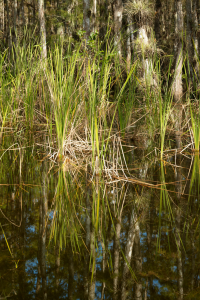If you are struggling to determine whether or not a part of your property is a wetland, you’re not alone. Many homeowners have the same question – and even experts have trouble agreeing on what’s considered a wetland. However, ecologists have greatly expanded our understanding of wetlands and have developed ways for property owners to identify them.
What is a Wetland?
A wetland is a transitional area between land and water; these areas are saturated with water, or even covered by shallow water and puddles for a part of the year. These wet conditions determine the type of plants and soil there. Specialists look for unique soils associated with wetlands – called hydric soils – and hydrophytes, or plants that can grow in saturated soil.

There are five basic types of wetlands:
- Wetlands that are completely saturated with salt water.
- A wetland in an estuary, with a mix of salt and fresh water.
- Freshwater wetlands that are close to rivers and streams.
- Freshwater wetlands that border lakes.
- Any kind of wetland that doesn’t fit into the above categories (like swamps, bogs, or marshes).
Why are Wetlands Disappearing?
Until the 1970s, the government actually encouraged landowners to drain and fill wetlands to accommodate agriculture, forestry, mining, and other economic developments. While policies have changed, today’s wetland regulations are still few and far between, which leaves many wetlands in danger of being drained and filled.
There are Wetlands on My Property. Now What?
There are ways to protect your wetlands without giving up property value or having to move. Here are some of the simplest things you can do to ensure the maintenance of this valuable ecosystem:
- Put up a fence. Even if you can’t lay a fence around your entire wetland, you can locate where people might have access to dump trash on your land and fence there. Better yet: federal cost-sharing money may be available to help offset the costs of putting up a fence.
- Make sure your septic system is working correctly. If you notice the area over your drain field is particularly green, or if you can smell sewage during rainy spells, call a septic system repair technician right away for an inspection. Draining sewage into your wetlands is harmful and unpleasant.
Wetlands are among some of Alabama’s most important and beautiful features. Come see them for yourself – and consider one of our beautiful wetland properties!



Leave a Reply